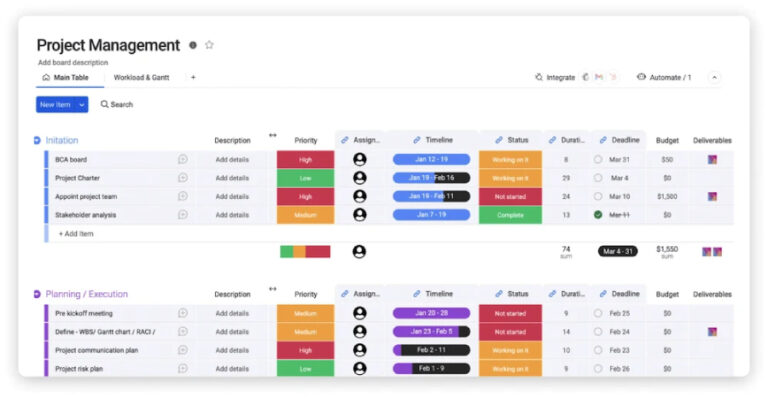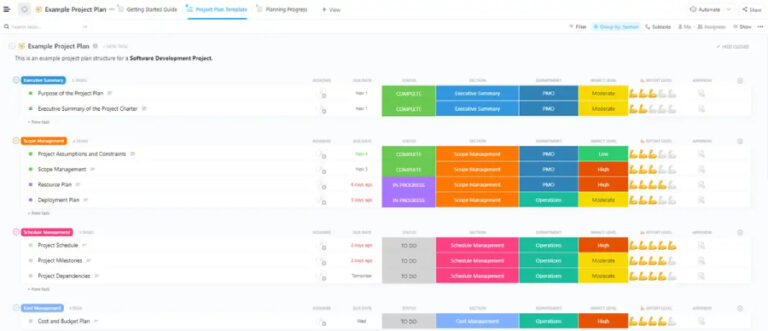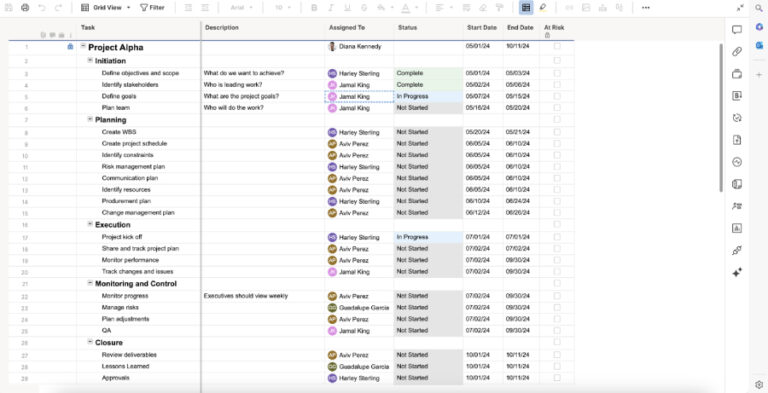Key takeaways
A project management plan serves as the blueprint for achieving the objectives and goals of a project. It details the hows, whens, and what-ifs of the project execution. Within this plan, you’ll find essential components such as the project’s purpose, execution steps, resource allocation, communication protocols, risk assessment, all team roles and responsibilities, all tasks with timing, and deliverables.
Without a well-defined project management plan, project management professionals and their organizations risk lost time, poorly assigned resources, and missed deadlines. Let’s delve deeper into why a robust project management plan is crucial for success.
5 Steps to Creating a Project Management Plan
In the arena of project management, a well-crafted project plan is the compass that guides teams toward their goals. Whether you’re launching a new product, organizing an event, or implementing a complex technology, a comprehensive project management plan ensures an easier ride to success.
Let’s explore the five critical phases of project management plans—initiation, planning, execution, monitoring, and closure—that form the backbone of well-thought-out project planning and serve as an undeniable tool every project manager is expected to understand and master.
1. Project Initiation
At the outset of project planning, the initiation phase takes center stage. This critical step establishes the foundation for the entire endeavor, defining the project’s purpose, scope, objectives, and team composition. By meticulously following these essential steps, you pave the way for a robust project management plan.
Define project objectives and scope
Begin your project management journey by establishing clear and measurable objectives that align with the project’s purpose. These objectives serve as the highway signs, ensuring that everyone involved understands the desired outcomes. Just as important is determining the project boundaries—what falls within the scope of work and what remains outside it. Setting up these parameters at the very beginning will set a solid foundation for you to build your project plan.
Identify key stakeholders and their roles
Identify the key stakeholders, often decision makers who hold the budget and influence final outcomes. Involve them from the outset to prevent last-minute surprises and conflicting requests.
Establish project goals and success criteria
As a project manager, your primary responsibility involves documenting project goals and understanding the shared vision of success. During the initial discovery meeting, collaborate with stakeholders to ensure accurate briefs and documents capture the project’s essence—its purpose, objectives, and desired results within specified timelines. Obtain approval from a lead stakeholder before proceeding further.
Select the team
Leverage past experiences to identify the right leads, subject matter experts (SMEs), and skilled professionals. Consider whether any vendors, contractors, or external organizations need inclusion. Create a workstream lead chart, listing each team member’s title, contact details, and role. Highlight the approvers as well. This A-team will be with you from day one until project completion. Reach out to each member individually, introduce yourself, and ignite their enthusiasm for collaboration!
2. Project Planning
Now we transition to the project planning phase, a pivotal stage where we lay the groundwork for project success. Here we detail the steps required to achieve the project goals. This includes establishing budgets, defining timelines, and setting meaningful milestones. Sourcing materials and gathering necessary documents become our project map. It is also appropriate timing to calculate and predict risks, implement change processes, and meticulously outline communication protocols. Get ready, as this phase is where the project truly takes shape.
Develop a work breakdown structure (WBS)
The work breakdown structure, or WBS, is a project management term that refers to a method of organizing a project into multiple tasks. It serves as the foundation for successful project execution—a hierarchical representation of the project scope, breaking it down into smaller, more manageable components. It organizes work into discrete tasks, making it easier to allocate resources, estimate time, and track progress. You create a WBS by identifying deliverables, breaking each down into smaller, more manageable sub-deliverables, organizing these tasks hierarchically and visually, and assigning unique details to each item for easy reference and guidance. This is a collaborative effort between the project manager, project stakeholders, and team leads.
Read more: What Is a Work Breakdown Structure?
Identify project tasks and milestones
Clearly outline the timeline with milestones and tasks. If no documented process exists, brainstorm with team leads to create one. Break down the work into specific, detailed tasks and sub-tasks, noting dependencies. Highlight milestones as key achievements to work towards.
Estimate resources, time, and costs
Begin by assessing your team’s expertise, skills, availability, and past performance. It is beneficial to understand your company’s project management process and how estimation fits into it. Pull historical data to identify trends and create a cost breakdown structure (CBS) to outline tasks, resources, and tools needed. Don’t forget to include stakeholders and experts for detailed input and document any assumptions for reference. To make things easier, utilize project management tools to simplify cost estimation, resource management, and scheduling so you are not building from scratch.
Create a project schedule and timeline
This will be the most work upfront for a project manager, and the outcome will make everything else move smoothly. A detailed project schedule outlines the timeline, milestones, and deadlines. It serves as the master map for achieving project goals. Make it accessible in a document or project management tool to keep the team organized.
Define project constraints and assumptions
Project assumptions are beliefs based on experience and available information, while constraints are known limitations. Assumptions guide planning, while constraints—such as scope, cost, and time—shape project execution. Both are documented in the project plan to manage risks and ensure successful delivery. You can use the format of a log as part of the project documentation, such as the scope document, to list and detail these out alongside each other.
Develop risk management strategies
Risk management involves identifying potential project risks and creating mitigation plans. The best way to minimize risks is to anticipate and proactively manage them. Maintain a risk log, update it as needed, and review with the team regularly. Document risk details, including responsibilities, resolution actions, and all the times when a risk is resolved.
Establish communication protocols
A project communication protocol is a structured framework that outlines the methods, frequency, and channels of communication among project stakeholders. To make sure that information is exchanged effectively during the project, decide and detail guidelines on which tools to use for meetings and messages, the frequency of meetings and reports, who is responsible for sending, receiving, approving, and responding, and an appropriate escalation process of steps to be taken when urgent decisions are required.
Manage resources
A tricky and ever-changing landscape every project manager can struggle with is resource management, which involves identifying and allocating skills, expertise, equipment, and materials for a project. It includes meticulous task assignments, workload reviews, and proactive planning on an ongoing basis until the work is complete. Project management tools can assist in planning and balancing complex workloads so no team member is left behind or looking for something to do.
Devise an efficient procurement plan
Obtaining the necessary goods and services from external sources for a project is another important step when it comes to planning a project. Focus on identifying the resources needed from external suppliers or vendors and detail that out in a statement of work. Involve stakeholders, as they can provide valuable input and alignment with project goals. Review bids, select a vendor, and finalize the contract. Once the work kicks off, this will turn into managing the relationship and checking off deliverables.
Come up with a change management plan
There may come a point during a project when change is necessary due to external factors, internal pressure, or evolving requirements. Begin by discussing the need for change with stakeholders and how it might impact in-process work. Plan and design the change with the help of stakeholders, team members, sponsors, and end-users. When ready, put the plan into action by coordinating activities and monitoring their progress.
3. Project Execution
Once the project plan is in place, the project execution phase begins. This stage puts the plan into action: resources are allocated, tasks are assigned, and team members collaborate to complete deliverables. Effective communication and coordination address any issues or changes. The project manager monitors progress, manages risks, and ensures quality standards, keeping the project aligned with scope, schedule, and budget. This phase is critical, as it transforms the plan into tangible results, driving the project toward completion.
4. Project Kickoff
The project kickoff, led by the project manager with input from key team leads, marks the official start of the project. Host a successful kickoff meeting after the discovery phase and when you’re ready to begin work. Key agenda items include project expectations, deadlines, project details, and any necessary adjustments.
Implement the project management plan
Now is the time to start using the detailed project management plan so much time was spent researching and detailing. This step involves executing the defined tasks, monitoring progress, and adapting as needed. Key steps include assigning responsibilities, tracking milestones, managing risks, and maintaining effective communication.
Monitor project progress and performance
Regularly review the plan to ensure alignment with project goals and adjust as necessary. Collect data and track metrics, review in status meetings, and discuss progress, challenges, and upcoming tasks with the team. Use a Gantt chart or other tool to visualize all tasks, dependencies, and milestones, and address any issues promptly.
Manage changes and address issues
This project stage requires constant attention, proactive planning, keeping senior leadership and stakeholders informed, and using a structured change management plan to actively manage any changes or issues. The keys to success are transparency, communication, and feedback.
5. Project Monitoring and Control
The project monitoring and control phase brings the project managers and teams together in an effort to closely track progress, assess performance, and make necessary adjustments to ensure that the project stays on course.
Continuously monitor project performance and adjust as needed
Establishing key performance indicators (KPIs) aligns metrics with project objectives. Use project management software to list and track KPIs throughout the project. Key steps for continuous monitoring include risk assessment, change control, resource allocation, and budget checks.
Read more: Risk Assessment Matrix: What It Is and How to Use It
Track progress against the plan
Regularly monitor performance using project management tools and gather progress reports from team members. Be flexible and adjust goals or timelines as needed. Continuously monitor resource allocation and budget, ensuring team members have necessary tools and support.
Monitor risks and implement mitigation strategies
Conduct regular risk assessments, develop mitigation strategies, and adjust the project plan accordingly. Add risks as they arise to the risk tracker that you share regularly for review with the extended team. Maintain transparency by providing regular status updates to stakeholders and clients so there are no surprises.
Address deviations from the plan
Expect changes and be ready for them by identifying when the project has deviated from the original plan, evaluate its cause and impact, and develop and execute a corrective action plan with the help of stakeholders. Revise the plan and resources as needed. Work to prevent future deviations by learning from the current situation.
Quality control
To ensure successful outcomes, develop a quality management plan that outlines activities and resources for meeting quality objectives. Include clear quality goals and standards, and adhere to project requirements. Regularly perform quality assurance through inspections, reviews, and tests, promptly addressing deviations. Implement processes for monitoring and controlling quality, using corrective actions and continuous improvement.
Project Closure
As we approach the final stages of the project, it is time to focus on the activities needed to close out the project. Include these items in your list of project closure to-dos.
Review project objectives and deliverables
Take an inventory of the objectives and all deliverables and verify that they align with the work that has been completed. Finalize any remaining deliverables and obtain client or approver acceptance.
Conduct lessons learned
Organize and host lessons learned or post-mortem meetings with the team. Good or bad, learn from the experience as a team and document project successes and challenges for future reference.
Obtain project sign-off and close out contracts
Review all documentation, verify there are no pending invoices, and update the final budget. Seek and collect official sign offs from all relevant stakeholders, including the client, end-users, the project sponsor, your PMO, and any project suppliers or vendors.
Archive documentation and files
Identify and catalog all project documents, including contracts, plans, scope documents, budgets, schedules, and other relevant files. Implement a standard naming convention and archive them along with any project files in a set place on the company servers or cloud space. Preserve this information for the future, as you never know when you may need to reference past work.
Free Project Plan Templates
Check out these templates and select the one that best satisfies your project needs.
Customizable project management plan template
monday.com’s template can be customized with ease to match the specifics of your project.

Simple project plan template
ClickUp’s project plan template is perfect for novice project managers as it is ready to use and easy to understand.

Comprehensive project management plan template
Smartsheet’s sample template is comprehensive and contains all the important elements of a project management plan.

Things to Consider Before Creating a Project Management Plan
Plan ahead for project success by considering the following key components of a project plan before creating one.
- Project objectives: Clearly define the desired outcomes, deliverables, and purpose.
- Project scope: Determine what is included and excluded.
- Resource allocation: Identify required people, budget, and tools.
- Timeline and milestones: Set deadlines and key deliverable dates.
- Budget: Define or access the budget for the project.
- Risk assessment: Anticipate risks and develop mitigation strategies.
- Communication plan: Create a plan for formal and effective communication with all parties throughout the life of the project.
- Tools and documentation: Identify which tools to use for documenting, tracking, and completing work and provide everyone access following kickoff.
6 Best Practices for Mastering a Project Management Plan
1. Define clear goals for the project
Start by identifying its objectives and desired outcomes, and clearly articulate what success looks like. Assess if the project has been done before and determine what needs to be achieved. Establish how success will be measured and confirm buy-in from key leaders and the organization. Evaluate the project’s priority, including whether there is an MVP or multiple phases. Identify necessary resources, both internal and external, and establish a timeline for completion.
2. Map out the scope of the work
To map out the scope of work for a project, first understand the overall scope, including deliverables, constraints, and boundaries. Clearly define what is in and out of scope. Determine the budget, noting if it is fixed or phased. Identify specific deliverables and confirm if there is a fixed deadline and the factors driving it.
3. Develop an outline and build the plan
Create a structured plan that details tasks, milestones, and dependencies. Break down the work into manageable components, identifying key milestones and workstreams. Note dependencies between tasks, make educated estimates for new work, and add buffers. Draft the plan, review, and finalize it for execution.
4. Share with stakeholders and the project team
Share the project plan with stakeholders and the project team, present your initial plan, and seek their input to ensure alignment and buy-in. Clearly explain the project’s details, including objectives, scope, and milestones. Ensure the appropriate leads are assigned to each workstream, even if they need to delegate tasks. Highlight potential risks and obtain approval from the team on both the draft and final plans.
5. Consider risks
An unavoidable reality to address is project risk. Expertly navigate project risks by conducting a thorough risk assessment and planning for potential challenges. Address risky tasks early on to mitigate impact. Watch for scope creep, manage time constraints, control costs, and prevent miscommunication within the team to ensure project success.
6. Stay agile
To remain agile as you work through the project management plan, balance the triangle of scope, resources, and schedule while prioritizing quality and adaptability. Regularly review and adjust processes to meet evolving needs and stay open to change. Embrace evolving requirements and incorporate agile practices into your plan, even if this is only one team’s methodology. Stay flexible and responsive to the sprint-based work environment, even if you choose to just use a hybrid approach to the overall project.
Bottom Line
When creating a project management plan, clearly define project objectives, scope, and goals. List tasks with a set timeline, outline the budget, and establish an effective communication plan with stakeholders to ensure project success.





